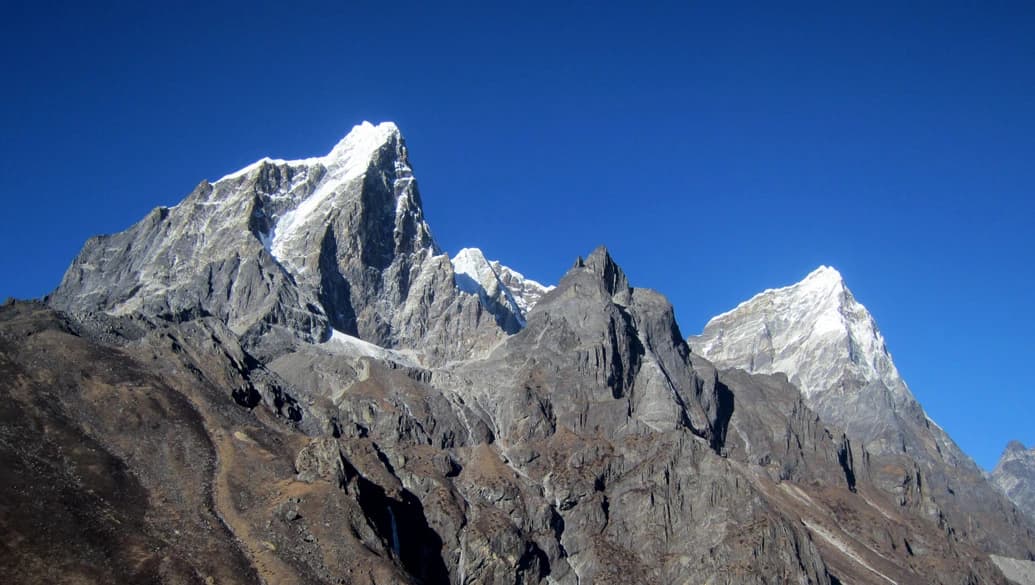Lobuche East Peak Climbing with EBC Trek Highlights
- The trek takes you to the heart of the beautiful Khumbu region.
- Walk through thrilling suspension bridges, small settlements, and dense green forests.
- Enjoy stunning views of the Himalayan range around you.
- Scenic flight from Kathmandu to Lukla and trek to Phakding along the banks of the Dudh Koshi River.
- Explore the beautiful Namche Baazar, the gateway to the Khumbu region.
- Walk around the ancient Tenboche Monastery, the largest in the region, and learn about the culture, heritage, and history.
- Hike through the alpine forest of Dengboche.
- Marvel at the stunning views of Lhotse, Ama Dablam, and Makalu.
- Ascend to the Chhukung Ri or Nagarjun Hill to enjoy better views of the surrounding landscapes.
- Spend the night at Lobuche and interact with the locals and their lifestyle.
- Trek to the Everest Base Camp and Kala Patthar are some of Nepal's best vantage points.
- Climb to the summit of Lobuche East Peak.
Lobuche East Peak Climbing with Everest Base Camp Trek Overview
The Lobuche East Peak Expedition has two faces, Lobuche West (6,145m) and Lobucge East (6,119m). During our 20 days trek and climbing expedition, we will conquer the peak's east face. Climbing to the peak's east face is regarded as a smooth mountaineering experience, whereas the west peak requires more technical skill and expertise. Located above the serene Lobuche village, summiting the Lobuche East Peak Climbing is a remarkable once-in-a-lifetime journey. The combination of climbing and trekking in one package gives you an immersive experience in the Himalayan region of Nepal. Likewise, Lobuche East Peak Climbing with EBC Trek is also about unwinding yourself outside your comfort zone and pushing your limits. The first stretch of the expedition takes you through the beautiful Sherpa community, lush rhododendron forests, rivers, and meadows. The trail you will hike will cover picturesque villages such as Tengboche (3,860m), Pheriche (3,440m), and the Namche Bazaar (3,440m). Further ahead, the trail will ascend along the serene moraine of Khumbu Glacier, leading you to Lobuche Village. The following day, you will go to Kalapathar (5 545m) via Gorakshep and retrace the trail to Lobuche. Further, the journey's final stretch will take you to High Camp (5,300m) and the summit of Lobuche East (6,119m). During the trek, we will acclimate to several places to allow our bodies to adjust to the increasing elevation.
Best Time for Lobuche East Peak Climbing with Everest Base Camp
The weather in the Himalayan regions of Nepal is unpredictable. It varies from crisp and warm to stormy and cold. So, learning about climate patterns is essential to choose the best time to begin your remarkable expedition to Lobuche East Peak.
Lobuche East Peak Climbing in Spring Season
The weather in the base camp during Spring is quite chilly, but the trek is quite refreshing, with warm temperatures in the lower altitudes of the region. Trekkers can expect sunny days most of the time and even occasional snowfall while on the trail. You can enjoy the beautiful views of the mountains and rolling hills, with cold and fresh wind blowing into your body. Moreover, the blooming flowers in the surrounding terrain add aesthetics to the journey. The temperatures around this time average between 10-15 degrees Celsius during the day and fall to 5 Degrees at night in Base Camp.
Lobuche East Peak Climbing in Autumn Season
The weather and climate conditions of Autumn are pretty similar to that of Spring. You will experience cool, sunny, and bright days with crisp views of the surrounding landscapes. However, the temperature will drop significantly at higher altitudes between 5 to 10 Degrees Celsius. On the other hand, the temperature will rise between 15 to 20 Degrees Celsius during the day. Autumn will peak during October with a clear sky, spectacular views, and optimal weather conditions. These elements make Autumn a perfect choice for outdoor activities, including hiking, trekking, mountaineering, and camping in the Khumbu region.
Off-Season
Starting your Lobuche East Peak Climbing with Everest Base Camp is not recommended in the off-season, which includes Monsoon and Winter. The adverse weather conditions make the trail slippery and covered in thick snow. As a result, most trekkers avoid climbing the mountains at this time of the year. The weather starts to change, and the temperature will drop in December. At the base camp, the temperatures drop to an astounding -10 Degrees Celsius in Winter. This significantly increases the chances of blizzards and heavy snowfall and can cause frostbite at higher altitudes. On the bright side, trekking in the lower region will offer you breathtaking views of the glaciers, frozen lakes, and snow-covered mountains.
On the other hand, the downpours and wind storms during the Monsoon season will make any outdoor activity demanding and challenging. The temperature during this season, from June to September, ranges between -5 and 22 degrees Celsius. Besides, the occasional drizzling rain isn't always bad, as it clears the sky during the post-monsoon season, offering better visibility and a clear atmosphere.





